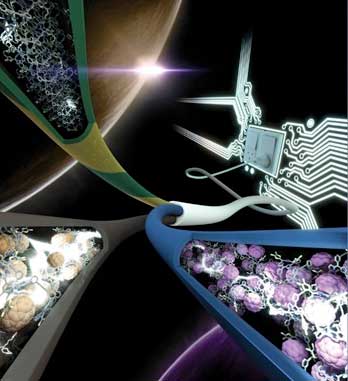| Jun 23, 2020 | |
Microscopic computers: The wires of the future may be made of molecules(Nanowerk News) Our computers are becoming more and more powerful all the time. They also often become smaller - just think of what a standard smartphone can do today compared to just a few years ago. |
|
| But the development cannot last. | |
| "With our current technology, we will soon reach the limit of how small the components within a computer can be," says Steffen Bähring from Department of Physics, Chemistry and Pharmacy, University of Southern Denmark. He studies molecules and for this study he investigated how good they are at conducting electricity. | |
| "The current technology based on silicon will reach the limit within the next 10 years and we do not yet have a technology ready to take over. But molecules are candidates to push the limit much further," he believes. | |
| Together with international colleagues Jonathan L. Sessler (Texas, USA), Dirk M. Guldi (Erlangen, Germany) and Atanu Jana (Shanghai, China), he has just published a new scientific study on the composition of molecules in liquids and as crystalline materials which proved particularly interesting. | |
| The study is published in the Journal of The American Chemical Society ("Semiconducting Supramolecular Organic Frameworks Assembled from a Near-Infrared Fluorescent Macrocyclic Probe and Fullerenes"). | |

| |
| "We see really good conductivity qualities, which is an extremely important feature when talking about the development of electronic devices and computers of the future," says Bähring. | |
| He believes that if we want even more powerful computers than today, which also remain small, then the electronics have to transition to molecular dimensions, meaning the individual components will be under a nanometer in size. | |
| The new "molecular wire", which the researchers describe in their article, is a good example and an elegant system, he believes. | |
| Steffen Bähring explains the principle in the new molecular wire as follows: "This is the first time that only neutral molecules, which are capable of recognizing and finding each other in solution, are used, thus forming a well-defined three-dimensional structure having semiconductor properties. By inserting different components, we can modify the conductivity and thereby control the system. | |
| "Our system differs from previous ones, which are based on salts containing metals. These are not capable of forming different structures like our system." | |
| One challenge in building electronic devices from molecules is that the molecular wires must have satisfactory conducting properties. But there is also another challenge: stability. | |
| "It's extremely difficult to control things this small, and when we talk about molecular electronics, stability is the biggest weakness. These are electroactive materials, and when you supply them with energy, the molecules will be charged, and any weaknesses will cause the molecules to break," says Bähring. | |
| Such molecular instability is also known in the world we can see. An example is how the molecules in our skin change when the skin absorbs energy from the sunlight if we do not protect it with sunscreen. | |
| Moore's Law: Since the 1960's, technological development has been predicted by Moore's law: The number of transistors on a microchip will double approximately every two years. However the limit of that development will be reached within a few years. Partly because of the extreme heat created when more transistors are pressed together in less space. That is why a whole new type of technology is needed. |
| Source: University of Southern Denmark | |
|
Subscribe to a free copy of one of our daily Nanowerk Newsletter Email Digests with a compilation of all of the day's news. |
